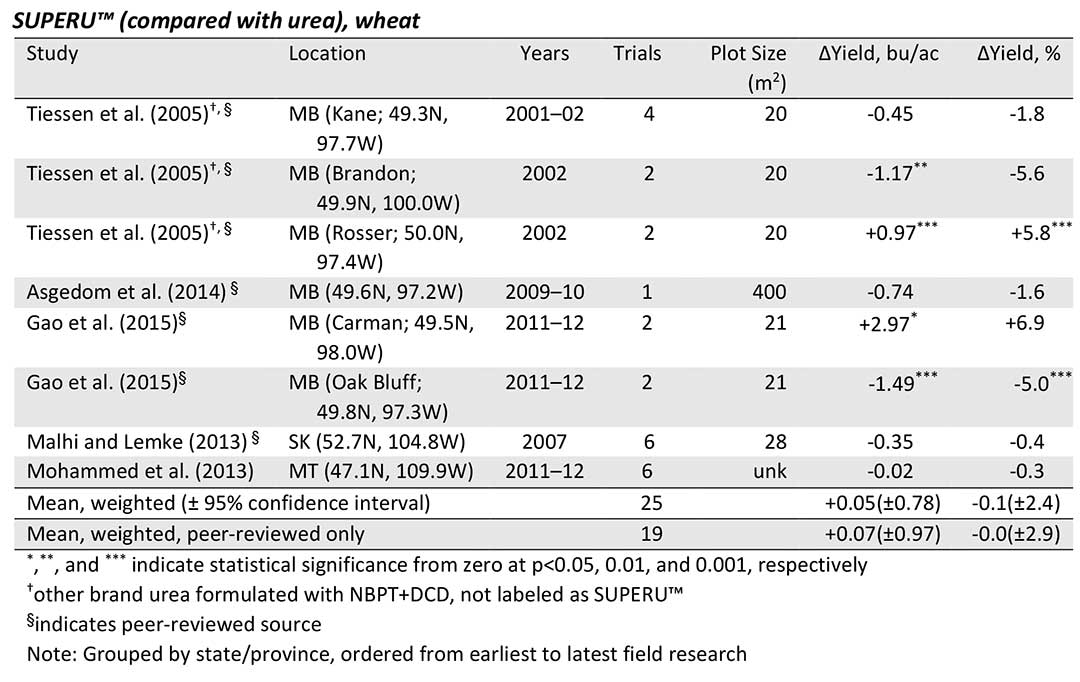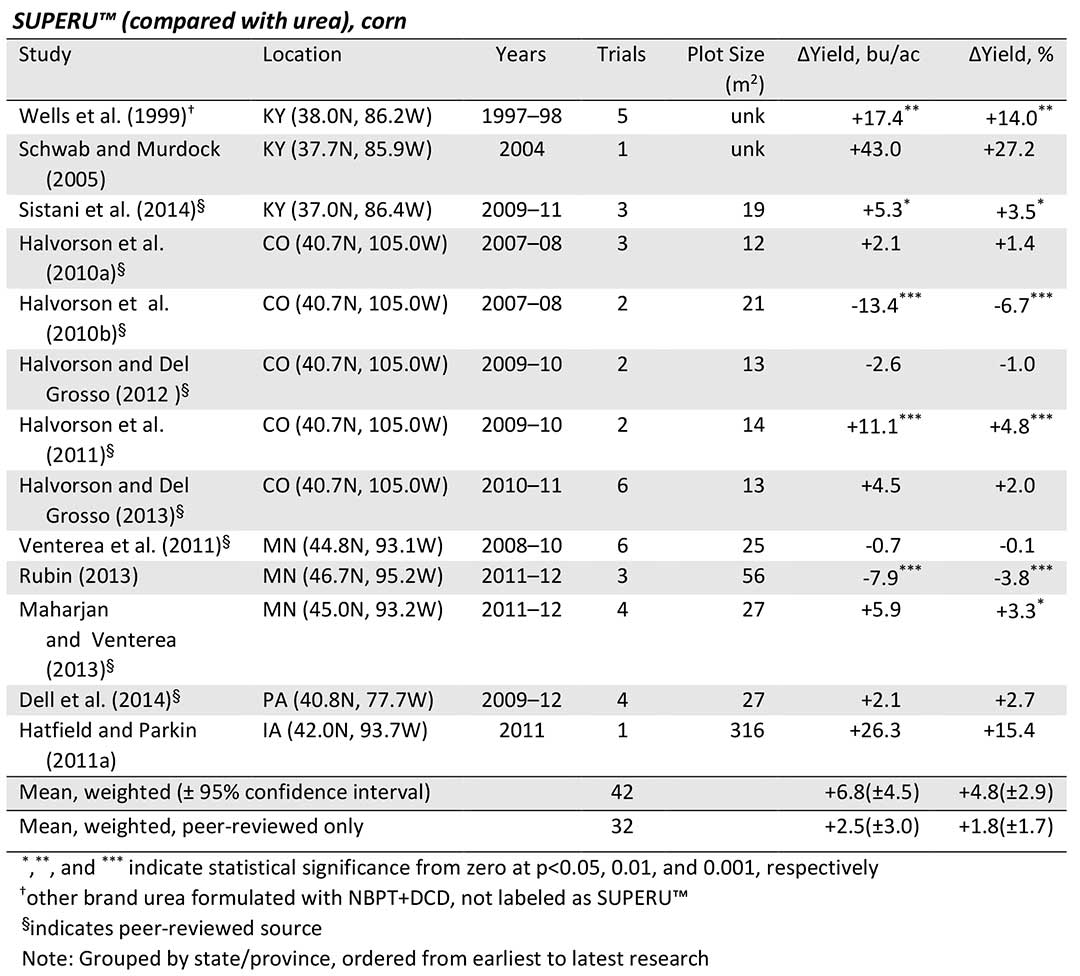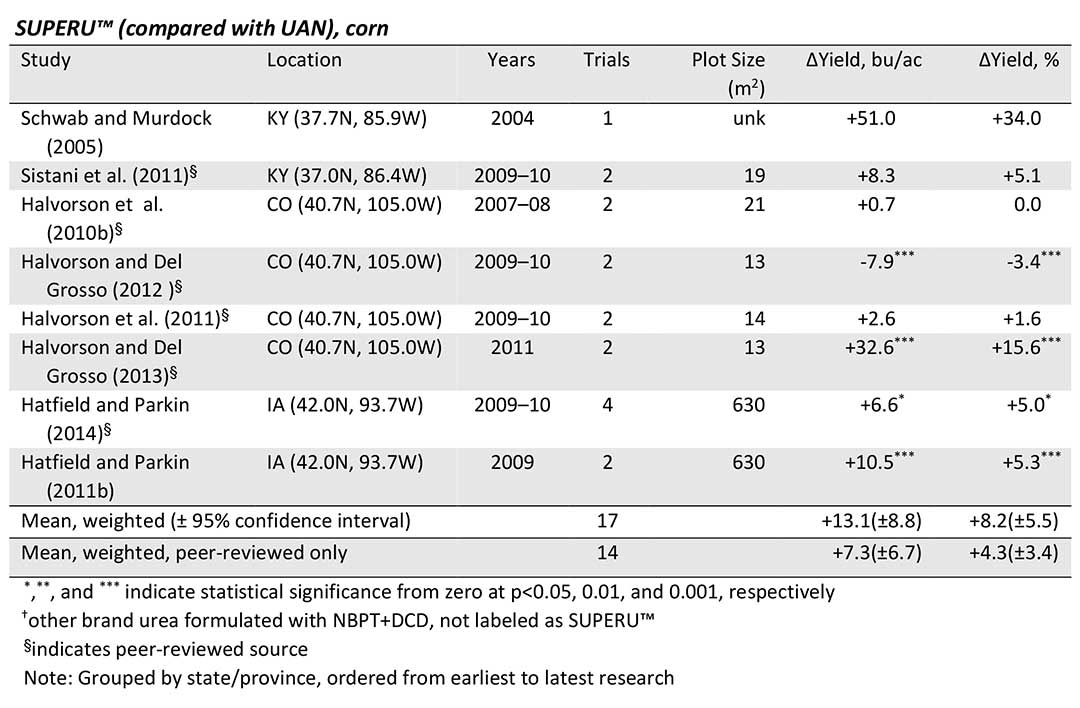SUPERU™ Research Findings
The research findings reported here were obtained from a literature review performed by Alison Eagle of Duke University (Nicholas Institute for Environmental Policy Solutions) in February 2016 under contract to the Environmental Defense Fund.
SUPERU™ is a self-contained granular fertilizer also intended to reduce ammonia volatilization and prevent nitrification, thus avoiding losses of ammonia to the air and nitrate to groundwater. It was available for on-farm use by the late 1990s and is made from a base of urea. It includes both NBPT and DCD, as does AGROTAIN® PLUS.
NBPT ((N-(n-butyl) thiophosphoric triamide) is a urease inhibitor. Dicyandiamide (DCD) is a nitrification inhibitor.
Urease inhibitors reduce the speed of conversion from urea in fertilizer to ammonium (enzymatic hydrolysis), which can then either rapidly convert to gaseous ammonia and be lost to the air or convert to nitrate (NO3-) and be subject to leaching losses. By staying longer in the urea form, the fertilizer can more slowly become available to plants, increasing the chance of being there when needed by the crop.
Nitrification inhibitors can increase nitrogen efficiency by depressing the activities of the Nitrosomonas bacteria over a period of time, therefore delaying the bacterial oxidation of the ammonium-ion (NH4+) into nitrite (NO2-), which is then transformed into nitrate (NO3-) by Nitrobacter and Nitrosolobus bacteria.
AGROTAIN®, AGROTAIN® PLUS, and SUPERU™ are related products manufactured and marketed by Koch Agronomic Services. All three products are sold to agricultural producers with the claim that they will improve nitrogen use efficiency and thus improve productivity. The expectation is that when N is limiting, effective urease and nitrification inhibitors will improve crop yield.
With the laboratory and other early work on these active ingredients already conducted for AGROTAIN® PLUS, early SUPERU™ research appears to be focused on field trials. The earliest field studies on corn in Kentucky took place in 1997 and 1998, reporting improved yields with the product (Wells 1999). Corn yield benefits (12-yr average) from both AGROTAIN® PLUS and SUPERU™ in Illionois depended on moisture conditions and whether or not fertilizer was incorporated (Ebelhar et al. 2007). The earliest peer-reviewed research results for SUPERU™ are field trials on corn that tested N2O emissions with different fertilizer sources and tillage treatments (Halvorson et al. 2010a; Halvorson et al. 2010b). These studies found both SUPERU™ and AGROTAIN® PLUS reduced N2O emissions significantly, when compared with urea and UAN.
A search of the scientific literature and grey literature (conference proceedings etc.) was conducted to locate data on crop yield responses for SUPERU™. Data were incorporated into an existing database on fertilizer management field trials, including all available management, climate, soil, N loss, and crop productivity information.
The following tables summarize the yield impacts of SUPERU™ with discussion below each table. Weighted averages are calculated where possible, with results from each study weighted by the inverse of the number of trials in each location. This prevents studies from very well-studied locations from overwhelming the average results.
Overall effect sizes are reported for all studies, and also restricted to peer-reviewed data and non-generic products, as applicable.

For wheat, there is no significant yield response to SUPERU™, for both the full dataset and when restricting to only peer-reviewed studies. Even without a yield response in these data, losses may be reduced, however, as Gao et al. (2015) observed an average reduction in yield-scaled N2O emissions of 33% (±28%). Because this is only for one location and a small number of observations, further study is needed to confirm the results, but it does agree with research in corn and other crops, and may be promising from an environmental stewardship perspective.

Out of 13 corn field studies, 3 experienced increased yield from using SUPERU™ instead of urea, 2 showed decreased yield, and 8 had no statistically significant effect. Overall, however, when compared to urea, the SUPERU™ resulted in an average yield increase between 2.3 and 11.3 bushels of corn per acre, or 1.9 to 7.7%. Including only the peer-reviewed data dampens that result, as there are only hints of positive yield benefits. Thus, more data may be useful. Even more important for environmental stewardship than yield, however, are the reported reductions in N2O emissions, as many of these studies also measured N2O emissions (32 observations). Yield-scaled N2O emissions were reduced by 22.1% (±10.6%) when replacing urea with SUPERU™.

Because SUPERU™ is a urea-based fertilizer, most studies have compared this product with urea. But what if the typical fertilizer in a region is something else, and farmers are considering alternatives? All SUPERU™ observations in the table above comparing with UAN were separate experiments from those comparing with urea. Compared with urea, there seems to be a greater yield benefit to replacing UAN with SUPERU™, but this may be affected by both the inhibitors and the fertilizer formulation (urea versus UAN) itself. Again, when restricting to peer-reviewed studies only, the estimated effect is lower. For the studies that reported N2O emissions (10 observations), yield-scaled N2O losses for SUPERU™ may be lower than for UAN, with an average decrease of 2.9% (± 3.7), again not significantly different, but this is likely due to the small number of observations.
When looking at yield effects only and keeping fertilizer rates constant, positive yield impacts for corn are evident for AGROTAIN® and SUPERU™, but the evidence is less compelling for AGROTAIN® PLUS. Limiting the analyses to peer-reviewed data reduces the effect size (in almost all cases) and reduces the statistical significance of positive impacts (primarily because of fewer observations). Overall, yield benefits for wheat from AGROTAIN® seem to be more an effect of reduced seedling damage by fertilizer than any reduced losses. Thus, the benefits were affected by fertilizer placement. There is no overall wheat yield response to SUPERU™. Perhaps this is a function of the overall lower N requirements for wheat compared to corn. Beneficial impacts of products containing NBPT and DCD were further modified by climate. For example, adding AGROTAIN® to urea was especially effective in dry conditions, when ammonia losses would be significant.
However, yield impact of a product without changing N fertilizer rate may not be the optimal measure of whether or not these products positively affect nitrogen efficiency. Perhaps studies with multiple rates would find similar yields from these products even with less overall N applied. Such results would be expected when a product improves N use efficiency. Many of the experiments from which data are currently available are not in systems where N is limiting the crop productivity, so the product may not have had opportunity to demonstrate its potential.
Further, environmental benefits may be achieved even without economic or production gains if damaging forms of N losses are reduced. The measured 22% lower yield-scaled N2O emissions from SUPERU™ compared with urea in corn systems represent significant improvements. A similar trend also seems possible for AGROTAIN® PLUS and SUPERU™ replacing UAN in corn systems. Therefore, while more data would of course be useful, these products do show some evidence of improving crop yield and reducing negative environmental impacts related to N losses.
Asgedom, H., M. Tenuta, D.N. Flaten, X. Gao and E. Kebreab. 2014. Nitrous oxide emissions from a clay soil receiving granular urea formulations and dairy manure. Agronomy Journal 106(2):732–44.
Ashworth, J. and G. Rodgers. 1981. The compatibility of the nitrification inhibitor dicyandiamide with injected anhydrous ammonia. Canadian Journal of Soil Science 61(2):461–63.
Beyrouty, C.A., L.E. Sommers and D.W. Nelson. 1988. Ammonia volatilization from surface-applied urea as affected by several phosphoroamide compounds. Soil Science Society of America Journal 52(4):1173–78.
Bremner, J.M. and H.S. Chai. 1986. Evaluation of N‐butyl phosphorothioic triamide for retardation of urea hydrolysis in soil. Communications in Soil Science & Plant Analysis 17(3):337–51.
Dell, C.J., K. Han, R.B. Bryant and J.P. Schmidt. 2014. Nitrous oxide emissions with enhanced efficiency nitrogen fertilizers in a rainfed system. Agronomy Journal 106(2):723–31.
Ebelhar, S.A., C.D. Hart, J.D. Hernandez, L.E. Paul, J.J. Warren and F. Fernandez. 2007. Evaluation of new nitrogen fertilizer technologies for corn. In Proceedings of the Illinois Fertilizer Conference Proceedings.
Fox, R.H. and W.P. Piekielek. 1993. Management and urease inhibitor effects on nitrogen use efficiency in no-till corn. Journal of Production Agriculture 6(2):195–200.
Gao, X., H. Asgedom, M. Tenuta and D.N. Flaten. 2015. Enhanced efficiency urea sources and placement effects on nitrous oxide emissions. Agronomy Journal 107(1):265–77.
Gioacchini, P., A. Nastri, C. Marzadori, C. Giovannini, L.V. Antisari and C. Gessa. 2002. Influence of urease and nitrification inhibitors on N losses from soils fertilized with urea. Biology and Fertility of Soils 36(2):129–35.
Grant, C.A. 2014. Use of NBPT and ammonium thiosulphate as urease inhibitors with varying surface placement of urea and urea ammonium nitrate in production of hard red spring wheat under reduced tillage management. Canadian Journal of Plant Science 94(2):329–35.
Halvorson, A.D. and S.J. Del Grosso. 2012. Nitrogen source and placement effects on soil nitrous oxide emissions from no-till corn. Journal of Environmental Quality 41(5):1349–60.
Halvorson, A.D. and S.J. Del Grosso. 2013. Nitrogen placement and source effects on nitrous oxide emissions and yields of irrigated corn. Journal of Environmental Quality 42(2):312–22.
Halvorson, A.D., S.J. Del Grosso and F. Alluvione. 2010a. Tillage and inorganic nitrogen source effects on nitrous oxide emissions from irrigated cropping systems. Soil Science Society of America Journal 74(2):436–45.
Halvorson, A.D., S.J. Del Grosso and F. Alluvione. 2010b. Nitrogen source effects on nitrous oxide emissions from irrigated no-till corn. Journal of Environmental Quality 39(5):1554–62.
Halvorson, A.D., S.J. Del Grosso and C.P. Jantalia. 2011. Nitrogen source effects on soil nitrous oxide emissions from strip-till corn. Journal of Environmental Quality 40(6):1775–86.
Hatfield, J.L. and T.B. Parkin. 2011a. Evaluation of alternative forms of nitrogen fertilizer on agronomic performance and nitrous oxide emissions. National Laboratory for Agriculture and the Environment, Ames, IA. 4 pp.
Hatfield, J.L. and T.B. Parkin. 2011b. Nitrogen management: Unraveling the effects of timing and form. 41st North Central Extension-Industry Soil Fertility Conference 27:1–8.
Hatfield, J.L. and T.B. Parkin. 2014. Enhanced efficiency fertilizers: Effect on agronomic performance of corn in Iowa. Agronomy Journal 106(2):771–80.
Hendrickson, L.L. 1992. Corn yield response to the urease inhibitor NBPT–5-year summary. Journal of Production Agriculture 5(1):131–37.
Hendrickson, L.L. and E.A. Douglass. 1993. Metabolism of the urease inhibitor N-(n-butyl) thiophosphoric triamide (NBPT) in soils. Soil Biology and Biochemistry 25(11):1613–18.
Jiao, X., W. Liang, L. Chen, Y. Jiang and D. Wen. 2004. Effects of urease/nitrification inhibitors on soil available N and microbial biomass N and on N uptake of wheat. Yingyong Shengtai Xuebao 15(10):1903–06.
Lamond, R.E., W.L. Thomas, D.A. Whitney, L.D. Maddux, W.B. Gordon, and V.L. Martin. 1994. Nitrogen management for no-till production systems. Proceedings of the 24th North Central Extension-Industry Soil Fertility Conference 10:1–9.
Maharjan, B. and R.T. Venterea. 2013. Nitrite intensity explains N management effects on N2O emissions in maize. Soil Biology & Biochemistry 66:229–38.
Malhi, S.S. and R.L. Lemke. 2013. Effectiveness of seedrow-placed N with polymer-coated and NBPT-treated urea for canola and wheat. Journal of Plant Nutrition 36(14):2205–24.
Malhi, S.S., E. Oliver, G. Mayerle, G. Kruger and K.S. Gill. 2003. Improving effectiveness of seedrow-placed urea with urease inhibitor and polymer coating for durum wheat and canola. Communications in Soil Science and Plant Analysis 34(11–12):1709–27.
Malzer, G.L., K.A. Kelling, M.A. Schmitt, R.G. Hoeft and G.W. Randall. 1989. Performance of dicyandiamide in the North Central states. Communications in Soil Science & Plant Analysis 20(19–20):2001–22.
Mohammed, Y.A., T. Jensen, J. Heser and C. Chen. 2013. Inhibitors, method and time of nitrogen application for improved winter wheat production in central Montana. In Proceedings of the Western Nutrient Management Conference, Reno, NV.
Motavalli, P.P., K.A. Nelson and S. Bardhan. 2013. Development of a variable-source N fertilizer management strategy using enhanced-efficiency N fertilizers. Soil Science 178(12):693–703.
Murphy, T.L. and R.B. Ferguson. 1997. Ridge-till corn and urea hydrolysis response to NBPT. Journal of Production Agriculture 10(2):271–82.
Nastri, A., G. Toderi, E. Bernati and G. Govi. 2000. Ammonia volatilization and yield response from urea applied to wheat with urease (NBPT) and nitrification (DCD) inhibitors. Agrochimica 44(5–6):231–39.
Reddy, G.R. 1964. Effect of mixing varying quantities of dicyandiamide with ammonium fertilizers on nitrification of ammonia in soils. Canadian Journal of Soil Science 44(2):254–59.
Rubin, J.C. 2013. Influence of Nitrogen Rate on Corn Grain Yield, Nitrogen Use Efficiency, and Nitrate Leaching on Coarse-Textured Minnesota Soils, University of Minnesota.
Schlegel, A.J., D.W. Nelson and L.E. Sommers. 1986. Field evaluation of urease inhibitors for corn production. Agronomy Journal 78(6):1007–12.
Schwab, G.J. and L.W. Murdock. 2005. Nitrogen transformation inhibitors and controlled release urea. College of Agriculture. Univ. Kentucky, Lexington, KY.
Sistani, K.R., M. Jn-Baptiste and J.R. Simmons. 2014. Corn response to enhanced-efficiency nitrogen fertilizers and poultry litter. Agronomy Journal 106(2):761–70.
Sistani, K.R., M. Jn-Baptiste, N. Lovanh and K.L. Cook. 2011. Atmospheric emissions of nitrous oxide, methane, and carbon dioxide from different nitrogen fertilizers. Journal of Environmental Quality 40(6):1797–805.
Soliman, M.S. and M.A.A. Monem. 1995. Effect of method of N-application and modified urea on N-15 recovery by rice. Fertilizer Research 43(1-3):143–48.
Tiessen, K.H.D., D.N. Flaten, C.A. Grant, R.E. Karamanos and M.H. Entz. 2005. Efficiency of fall-banded urea for spring wheat production in Manitoba: Influence of application date, landscape position and fertilizer additives. Canadian Journal of Soil Science 85(5):649–66.
Trenkel, M.E. 1997. Controlled-Release and Stabilized Fertilizers in Agriculture. International Fertilizer Industry Association, Paris.
Varsa, E.C., A.K. Leis, and J.M. Jemison Jr. 1989. Response of no-till corn to urease inhibitors and placement of N sources. Proceedings of the 19th North Central Extension-Industry Soil Fertility Conference 5:1–10.
Varsa, E.C., S.A. Ebelhar, P.R. Eberle, E. Gerhard, and T. Wyciskalla. 1999. Evaluation of nitrogen management practices in no-till corn production. 29th North Central Extension-Industry Soil Fertility Conference 15:1–18.
Venterea, R.T., B. Maharjan and M.S. Dolan. 2011. Fertilizer source and tillage effects on yield-scaled N2O emissions in a corn-cropping system. Journal of Environmental Quality 40(5):1521–31.
Watson, C.J., H. Miller, P. Poland, D.J. Kilpatrick, M.D.B. Allen, M.K. Garrett and C.B. Christianson. 1994. Soil properties and the ability of the urease inhibitor N-(N-Butyl) thiophosphoric triamide (NBTPT) to reduce ammonia volatilization from surface-applied urea. Soil Biology & Biochemistry 26(9):1165–71.
Weber, H.S. and D.B. Mengel. 2009. Use of nitrogen management products and practices to enhance yield and nitrogen use efficiency in no-till corn. 39th North Central Extension-Industry Soil Fertility Conference Proceedings 25:1–7.
Wells, K.L., J.E. Dollarhide, and H.E. Burkwhat. 1999. Field evaluation of super urea for production of no-till corn. Agronomy Notes 31(1):1–6.
